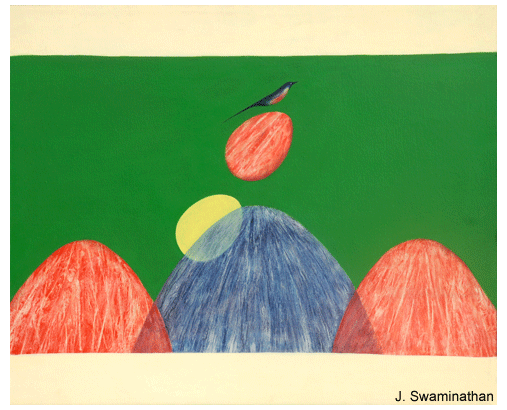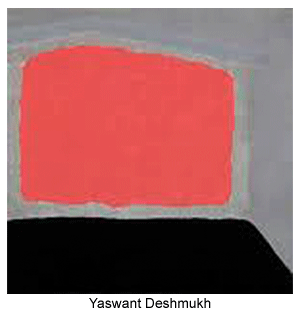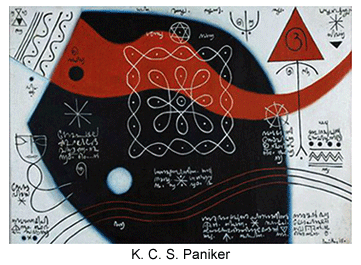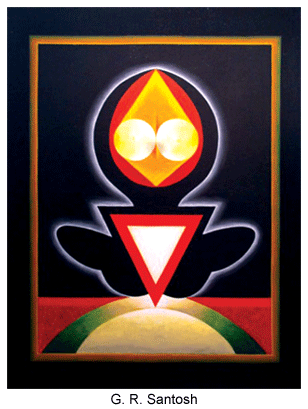- Prelude
- Editorial
- ...Where ever I stumble, let painting lie before me....
- ...Colour guides in its own direction...
- Abstract Art: Popular Myths and History
- Abstract Rhetoric:
- Ram Kumar: A transition from figurative to abstract
- I walk the line
- Exploring a twilight zone
- Articulating the Abstract voice from Madhya Pradesh
- Perception of Abstract in forms
- Confronting Cultures: The Dialectic of Abstraction in Bengal Art
- K.C.S. Paniker and his Words and Symbols
- Dialectics of Abstract Art and Its Indigenous Identity
- Between Ambivalence and Criticism: Why Abstraction?
- Notations and Rhythm in Space: Sushen Ghosh
- Victorian Era: Eclectic Furniture
- Patek Philippe : an overview
- The “Theme Pandals” of Durga Pujo: An Unexplored Discourse
- Musings on Music
- Butterflies in the stomach… still
- Contemporary Art Market Report 2009-10
- Artist Index and Statistics
- Auction Reports
- Recent works of Pavan kumar D. - In the Journey of Learning things
- Narrating “with a pinch of salt” Paintings of K.P.Reji
- Reclaiming an artist of true calibre
- Musings from Chennai
- An Annual Homage..
- Art Events Kolkata: September-October 2010
- Mumbai Art Sighting
- Art Bengaluru
- Unveiling the next in line
- Preview
- In the News
- Sotheby’s : Important Watches Hong Kong
ART news & views
Abstract Art: Popular Myths and History
Volume: 3 Issue No: 10 Month: 11 Year: 2010

Abstract art heralded the arrival of spring in modernism. Abstract art and its variants flourished during the middle decades of the 20th century, which also saw the shift of the international art hub from Europe to the USA. Political changes in the European countries had led to the mass migration of the intellectuals, scientists and artists to America, which in turn helped the United States to re-embellish its talent reservoir. For the migrated artists as well as the home grown artists, the post-World War II America provided a fertile land for cherishing and nourishing intellectual freedom. After recovering from the economic depression of the war years, America had already sent the message loud and clear to the commercial and intellectual world that it was now the world leader and they had evolved an art style or even a movement for the world to sit up, watch and follow.
This style of art was called 'Abstract Expressionism' and with Clement Greenberg and Harold Rosenberg as the high priests of this movement, America flaunted its artists like Jackson Pollock before the world. Abstract Expressionism also set up the theoretical ground for high modernism. Had modernism been a state of history in which the artists experimented on form and style, and also delved deep into the existential issues pertaining to human life, high modernism was a historical phase of the intellectual life where the ultimate human freedom was celebrated. Art was one of the ways of expressing this freedom and joy.  It disputed the canons of modern experiments and anchored itself to the spiritual freedom of the artist. Abstract Expressionism was the purest form of apolitical art of the 20th century.
It disputed the canons of modern experiments and anchored itself to the spiritual freedom of the artist. Abstract Expressionism was the purest form of apolitical art of the 20th century.
Art of abstraction was not a by-product of abstract expressionism. Early 20th century western art had shown the tendencies of art moving towards abstraction, which the artists considered closer to the purest of forms of art like music. Kandinsky was one of the early exponents of abstract art. The palette of the Fauves also was closer to abstraction. However, it did not develop into a major art form probably due to the lack of presentation and patronage. Most of the post-war artists of the west were looking towards the east in order to find a spiritual anchor. The serenity of eastern religions and the colours of the eastern art might have taken them on a guided tour into the paths of abstract art.
The origin, growth and development of Indian modern abstract art should be seen against this international backdrop. Abstract art became a huge movement in Indian art scene during the 1960s and the 1970s. Till then, Indian artists were caught between the debates of European academicism and Indigenous art practices. By the middle decades of the 20th century, Indian artists had initiated themselves into the modernist movements of the west. However, it was noticed that they were lagging a few years behind their western contemporaries. It was in abstract art that the Indian artists found an opportunity to be at par with their western and European counterparts as the principles and philosophy of abstract art were rooted in the eastern philosophy in general and the Indian philosophy in particular.
India has two major schools of abstract art: one led by J.Swaminathan and the other led by K.C.S.Paniker. Even today, abstract art comes predominantly from those artists who are trained in these schools. Besides, Indian abstract art also has several other variants which range from pure Tantric forms to the 'pure' play of colours and textures. J.Swaminathan moved towards abstraction after his stint with a sort of expressionist language. He was searching for the purity of existence and the works were the celebration of simple colours. Abstraction for him was not just the erasure of concrete forms, on the contrary Swaminathan experimented with the basic forms and flat colours, perhaps inspired by the landscapes of India. In Swaminathan's works you find the celebration of freedom as you see in the works of the western abstract artists, though Swaminathan's paintings are not as gestural and performative as those of the western artists.
J.Swaminathan's works are marked for their purity of form, flat surfaces, serene colors and the philosophical overtones attached to them. Abstract art, though a language in itself, needed another linguistic structure for its existence and proliferation. This literature built around these works was mainly philosophical in quality and apolitical in attitude. One could say, the abstract art brought along an art literature, which centralises artist and art as shamanistic entities.  Perhaps, this became handy for many artists who were less gifted than Swaminathan, and many of them took this abstract language to foreign shores where it was considered 'authentic' abstract language, and therefore exotic enough to be extolled.
Perhaps, this became handy for many artists who were less gifted than Swaminathan, and many of them took this abstract language to foreign shores where it was considered 'authentic' abstract language, and therefore exotic enough to be extolled.
K.C.S. Paniker, the erstwhile principal of Madras Art College, was another artist who made several experiments with painterly language in order to establish an authentic and indigenous art language. Though for Paniker and Swaminathan, their art was apolitical in nature, the reasons for establishing a new art language was a political act for it was considered to be an attempt to uphold the 'indigenous identity' of Indian art (or any intellectual manifestation of/from India) within the larger narrative of India as a nation as set against the same of the West. Paniker, an artist who was more interested in the impressionist and post-impressionist styles during his formative years, moved towards the abstract language of pure colour and forms, mainly as a search for establishing a political narrative of the nation through an indigenously styled art.
For Paniker, the traditional scriptures and mathematical tables were as exciting as the features of urban modernism. He found the potential of the words and symbols to evoke a sense of past and its allegiance to the present. His abstraction, unlike that of Swaminathan was inspired by the narratives of Indian traditional art. Paniker, inspired by the western artists like Paul Klee, found the potential of Indian Tantric philosophy. However, as seen in the falsified histories, Paniker was not attempting to revive a traditional Tantric diagrammatic language in art. He used certain symbols and words from traditional texts and as an artist his interest was in their visual values, not in their textual narratives. Paniker influenced a generation of artists most of whom experimented extensively with the abstract language they had inherited from Paniker, and later improved or improvised by themselves.
There has always been a major misunderstanding of abstract art by the artists themselves. Many of them still think that abstract art is all about Tantric art. This misinterpretation was unintentionally caused by a third but minor school of abstract art led by Biren De and G.R.Santhosh. These two artists were operating from the northern part of India. In their works one could see the sexual union of the male and female bodies as explained in the Tantric texts. The simplification of human bodies into geometrical and fluid forms was their way of producing abstract art. This was called 'neo-Tantric abstract art' thanks to the non-availability of better nomenclature.  The same categorization was also falsely imposed upon the Paniker School as it had also used some elements from the Tantric texts. Several artists even today think that abstract art is all about creating a simplified symbolism for sexual union.
The same categorization was also falsely imposed upon the Paniker School as it had also used some elements from the Tantric texts. Several artists even today think that abstract art is all about creating a simplified symbolism for sexual union.
Abstract art is not a dead art form of/from the last century. Several artists in India still use this art form quite effectively, and with a lot of passion and verve. J.J.School of Art has produced some very interesting artists who deal in abstract art. Prabhakar Kolte is an artist who has awakened a lot of artists to the possibilities of abstract art. Kolte's abstraction is neither analytical nor synthetic; there is a major concurrence between the artist's mind and action in his works. Kolte's abstraction has found resonances in the works of his many of his students including Bose Krishnamachari. Yaswant Deshmukh is one artist, who has a strong sense of abstraction, and in his works, Deshmukh brings the concrete shapes around him down to their bare essentials and these forms together create a great harmony in his works.
As is generally thought, the abstract is not about non-figuration. Abstract art may well have figures and forms in them; not as concrete bodies but as essential unities. Abstract art originates from the artist's intense engagement with the theme and form and his ability to go into the fundamentals and the essentials. As in Cubist art, Abstract art also could be analytical and synthetic. It could uphold a philosophy and could produce a set of political textual narratives around them even when its painterly content remains largely apolitical in nature. But unfortunately enough, many aspiring artists have taken abstract art for granted. For many of them abstraction is an escape route to avoid figuration, or a shield to cover their lack of skill. Somehow, symbolic representation and abstract art have become identical in popular parlance as 'modern art' as it is commonly assumed that neither abstract nor modern art makes any sense to an ordinary viewer. Many artists, by using this popular notion as a safeguard, still produce obscure art as 'abstract art' and get away with it. This has triggered the untimely collapse of abstract art in India.